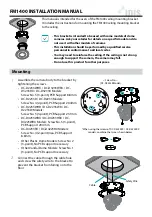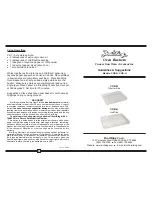
4
E4PA-N
Ultrasonic Displacement Sensor
Nomenclature
Setting Plug
The E4PA-N is set up by aligning the notch on the Sensor with one
of the triangular marks on the Setting Plug and inserting the Setting
Plug into the Sensor.
Note:
1.
Analog Output Characteristics when Setting Plug is inserted at E2/
E3 Position:
The analog output characteristics will change from (1) to (2) to (3),
in that order, each time the Setting Plug is inserted with the E2/E3
position aligned with the notch on the Sensor.
2.
The analog output value can be compensated so that the sensing
surface (0 mm) of the Sensor is 4 mA/0 V regardless of the nearest
sensing point setting.
This function is useful when using Controllers without a scaling
function. Sensing is not possible, however, for characteristics
within the dead band distance and current/voltage output values
may not be stable.
Indicator Display and Analog Output Characteristics
Note:
1.
Lit: The sensing object is within the sensing range.
Not lit: The sensing object is not within the sensing range.
2.
Output indicator just prior to occurrence of malfunction.
Mutual Interference Prevention
The E4PA-N provides a sync input to prevent mutual interference.
When the fifth pin of the Sensor I/O Connector’s M12 Connector is interconnected, mutual interference can be prevented for up to five Units. The
Sensors will mutually oscillate, however, causing a delay in measurement time by the mutual interference cycle time per Sensor
×
number of Units
+ response time. When the sync inputs are not connected, the mutual interference prevention function is disabled.
(For example, if three E4PA-LS200-M1-N are connected, the response time for one Sensor is 34 ms
×
3 S 195 ms = 297 ms.
Sensor
Setting Plug
Triangular mark on
Setting Plug
Notch on Sensor
Setting Plug
connector
M12 connector for
Sensor I/O (5 poles)
Notch on Sensor
RUN indicator (yellow)
Power indicator (green)
RUN indicator (yellow)
Error indicator (red)
Position
Function
A1
Nearest sensing point A1
A2
Farthest sensing point A2
E2/E3
(See note 1.)
Analog output characteristics
1. Increase: As the distance increases, the output in-
creases. (LED A2 flash.)
2. Output from 0 mm: Increases from the sensing surface
to point A2. (LED A1 and A2 flash.) (See note 2.)
3. Decrease: As the distance increases, the output de-
creases. (LED A1 flash.)
T
Temperature compensation setting (normal operating
condition)
0 mm
A2
A1
(1) Output increase mode
(3) Output decrease mode
(2) Output from 0 mm
Nearest point
Farthest point
20 mA/10 V
20 mA/10 V
4 mA/0 V
Dead band
distance
4 mA/0 V
20 mA/10 V
Status
Setting Plug
position
Power indicator
(green)
Error indicator (red)
RUN indicator A1
(yellow)
RUN indicator A2
(yellow)
Analog
output
Normal operation
Temperature compensation
T
Lit
Not lit
Lit/Not lit
(See note 1.)
Lit/Not lit
(See note 1.)
Present value
Setting Plug not inserted
Not lit
Lit
Lit/Not lit
(See note 1.)
Lit/Not lit
(See note 1.)
Present value
Malfunction sensing (when
detecting external distur-
bance)
Not lit
Flashing
Lit/Not lit
(See note 2.)
Lit/Not lit
(See note 2.)
No change or
unstable
Sensing distance A1 set-
ting
With sensing object
A1
Flashing
Not lit
Flashing
Not lit
No change
Without sensing object
Not lit
Flashing
Flashing
Not lit
No change
Sensing distance A2 set-
ting
With sensing object
A2
Flashing
Not lit
Not lit
Flashing
No change
Without sensing object
Not lit
Flashing
Not lit
Flashing
No change
Analog output characteris-
tics setting
(1) Output increase mode
E2/E3
Lit
Not lit
Flashing
Not lit
No change
(2) Output decrease mode
Lit
Not lit
Not lit
Flashing
No change
(3) Output from 0 mm
Lit
Not lit
Flashing (synchronous)
Flashing (synchronous)
No change
Power turned ON
None
Flashing
Not lit
Previous status
Previous status
No change
Downloaded from
Downloaded from
Downloaded from
Downloaded from



























